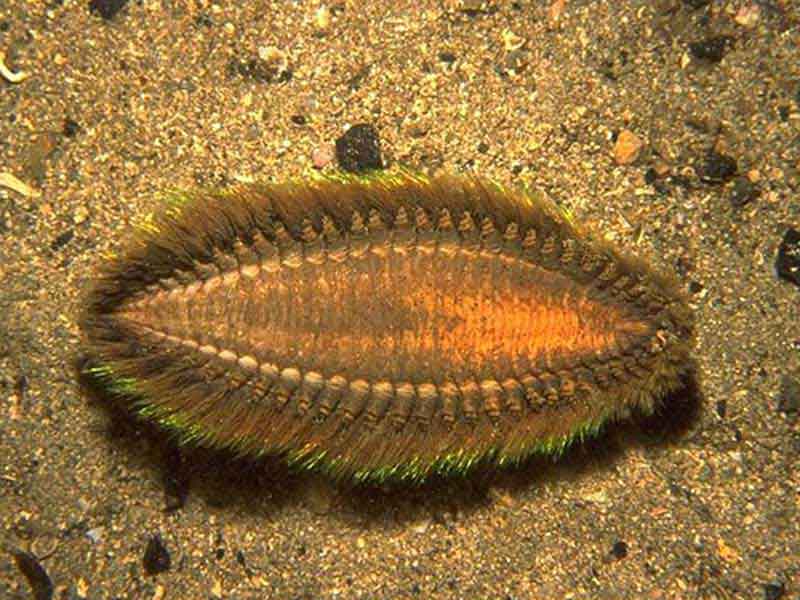The sea mouse (Aphrodita aculeata) is one of the most bizarre yet fascinating marine creatures found in the ocean depths. Despite its name, it is not a rodent but a species of polychaete worm belonging to the family Aphroditidae. With its iridescent bristles, soft body, and burrowing nature, this marine worm has long intrigued scientists and marine enthusiasts alike.
In this article, we will explore the scientific classification, physical characteristics, distribution, ecological role, behavior, diet, reproduction, and conservation status of the sea mouse while ensuring a comprehensive SEO-friendly structure.
| Category | Details |
|---|---|
| Kingdom | Animalia |
| Phylum | Annelida |
| Class | Polychaeta |
| Order | Phyllodocida |
| Family | Aphroditidae |
| Genus | Aphrodita |
| Common Name | Sea Mouse |
The sea mouse gets its name due to its furry appearance, which resembles the back of a real mouse when out of the water. It is often found in deep-sea environments, buried under sediment, where it plays an important role in the ecosystem.

The sea mouse has been scientifically documented for centuries, with its iridescent bristles being a major point of interest. Early naturalists were amazed by the optical properties of these chitinous bristles, which reflect different colors under light.
18th-19th century: European scientists first described and classified the species, noting its bioluminescent-like iridescence.
20th century: Researchers studied the polychaete nervous system, using sea mice as model organisms for studying marine worm locomotion.
Modern research: Focuses on the biomechanical properties of the bristles and their potential applications in optics and material science.
The sea mouse has a broad, oval body covered with bristle-like setae, giving it a fuzzy appearance.
Body Length: 7 to 30 cm (depending on species)
Width: 3 to 7 cm
Weight: Can weigh up to 200 grams
Color: Ranges from reddish-brown to golden, but under certain lighting, the bristles display iridescent hues of green, blue, and purple
One of the sea mouse’s most striking features is its highly reflective bristles, which appear different colors based on light angles. This unique property has attracted researchers interested in bio-optics and photonic materials.
Typically 3 to 5 years, though some individuals may live longer in favorable conditions.
The sea mouse is widely distributed in marine environments, primarily in cold and temperate waters.
Found in the North Atlantic Ocean, North Sea, and Mediterranean Sea
Some species occur along the coasts of North America and Europe
Depth Range: 20 to 2,000 meters
Preferred Environment: Soft seabed, including muddy and sandy ocean floors
Typically burrows into sediment, helping oxygenate the ocean floor.
The sea mouse plays a key ecological role in marine environments, helping to break down organic matter and aerate sediments.
Primarily sedentary, with limited movement.
Moves by pushing through sediment using its bristles and muscular contractions.
Mostly solitary, with minimal social interactions.
Nocturnal, becoming more active during the night to hunt for small invertebrates.
The sea mouse is a carnivorous scavenger, feeding on small marine creatures.
Small crustaceans
Mollusks
Dead fish and organic detritus
Uses its powerful jaws to crush prey.
Detects prey through sensory bristles, which pick up chemical signals from the surrounding water.
The reproductive cycle of the sea mouse remains poorly understood, but it follows typical polychaete worm reproductive strategies.
Separate male and female individuals (dioecious species).
Fertilization is external, with females releasing eggs into the water.
Larvae are planktonic, drifting in the ocean before settling on the seabed.
The sea mouse is not currently listed as an endangered species.
However, some species may face threats due to habitat destruction and deep-sea trawling.
Bottom trawling: Fishing nets damage the seabed, disrupting sea mouse populations.
Pollution: Microplastic contamination affects marine invertebrates.
Climate change: Changes in ocean temperature and acidity can alter habitat conditions.
Marine protected areas (MPAs) can help conserve sea mouse populations.
Sustainable fishing practices to minimize seabed disruption.
The sea mouse contributes to marine ecosystem balance by:
Aerating sediments, allowing oxygen to circulate.
Controlling small invertebrate populations.
Recycling organic matter, improving nutrient flow in the ecosystem.
The sea mouse’s iridescent bristles have been studied for ancient jewelry and decoration.
Some cultures view deep-sea creatures as symbols of mystery and transformation.
Scientific research: Used in optical materials and biomimicry studies.
Aquarium displays: Occasionally exhibited in marine research centers.
| Species Name | Common Name | Notable Feature |
|---|---|---|
| Aphrodita aculeata | European Sea Mouse | Found in North Atlantic |
| Aphrodita hastata | American Sea Mouse | Common off U.S. coasts |
| Aphrodita peruviana | Peruvian Sea Mouse | Found in South American waters |
The sea mouse (Aphrodita) is a truly unique marine creature, known for its iridescent bristles, burrowing behavior, and important ecological role. While often overlooked, it plays a crucial role in deep-sea ecosystems, helping maintain the balance of marine life.
With ongoing research into its optical properties and ecological significance, the sea mouse continues to be a subject of scientific curiosity and admiration.
If you found this article interesting, feel free to share your thoughts or ask questions in the comments!
animal tags: Aphroditidae
We created this article in conjunction with AI technology, then made sure it was fact-checked and edited by a Animals Top editor.